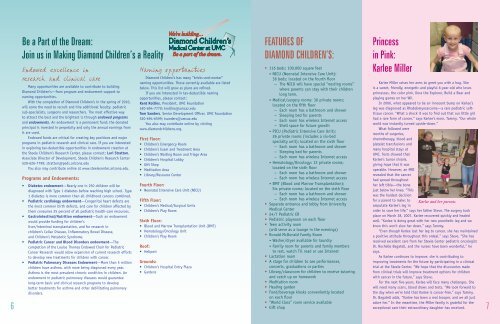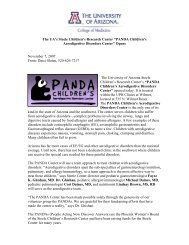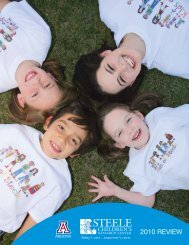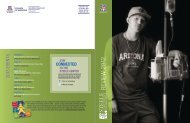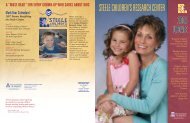Read More - the Steele Children's Research Center - University of ...
Read More - the Steele Children's Research Center - University of ...
Read More - the Steele Children's Research Center - University of ...
You also want an ePaper? Increase the reach of your titles
YUMPU automatically turns print PDFs into web optimized ePapers that Google loves.
Be a Part <strong>of</strong> <strong>the</strong> Dream:<br />
Join us in Making Diamond Children’s a Reality<br />
Endowed excellence in<br />
research and clinical care<br />
Many opportunities are available to contribute to building<br />
Diamond Children’s—from program and endowment support to<br />
naming opportunities.<br />
With <strong>the</strong> completion <strong>of</strong> Diamond Children’s in <strong>the</strong> spring <strong>of</strong> 2010,<br />
will come <strong>the</strong> need to recruit and hire additional faculty: pediatric<br />
sub-specialists, surgeons and researchers. The most effective way<br />
to attract <strong>the</strong> best and <strong>the</strong> brightest is through endowed programs<br />
and endowments. An endowment is a permanent fund; <strong>the</strong> donated<br />
principal is invested in perpetuity and only <strong>the</strong> annual earnings from<br />
it are used.<br />
Endowed funds are critical for creating key positions and major<br />
programs in pediatric research and clinical care. If you are interested<br />
in exploring tax-deductible opportunities in endowment creation at<br />
<strong>the</strong> <strong>Steele</strong> Children’s <strong>Research</strong> <strong>Center</strong>, please contact: Lori Stratton,<br />
Associate Director <strong>of</strong> Development, <strong>Steele</strong> Children’s <strong>Research</strong> <strong>Center</strong><br />
520-626-7799; stratton@peds.arizona.edu<br />
You also may contribute online at www.steelecenter.arizona.edu.<br />
Programs and Endowments:<br />
• Diabetes endowment—Nearly one in 250 children will be<br />
diagnosed with Type 1 diabetes before reaching high school. Type<br />
1 diabetes is more common than all childhood cancers combined.<br />
• Pediatric cardiology endowment—Congenital heart defects are<br />
<strong>the</strong> most common birth defects, and care for children affected by<br />
<strong>the</strong>m consumes 25 percent <strong>of</strong> all pediatric health-care resources.<br />
• Gastrointestinal/Nutrition endowment—Such an endowment<br />
would provide funding for children’s<br />
liver/intestinal transplantation, and for research in<br />
children’s Celiac Disease, Inflammatory Bowel Disease,<br />
and Children’s Metabolic Syndrome.<br />
• Pediatric Cancer and Blood Disorders endowment—The<br />
completion <strong>of</strong> <strong>the</strong> Louise Thomas Endowed Chair for Pediatric<br />
Cancer <strong>Research</strong> would allow expansion <strong>of</strong> current research efforts<br />
to develop new treatments for children with cancer.<br />
• Pediatric Pulmonary Diseases Endowment—<strong>More</strong> than 5 million<br />
children have asthma, with more being diagnosed every year.<br />
Asthma is <strong>the</strong> most prevalent chronic condition in children. An<br />
endowment in pediatric pulmonary diseases would guarantee<br />
long-term basic and clinical research programs to develop<br />
better treatments for asthma and o<strong>the</strong>r debilitating pulmonary<br />
disorders.<br />
Naming opportunities<br />
Diamond Children’s has many “bricks-and-mortar”<br />
naming opportunities. Those currently available are listed<br />
below. This list will grow as plans are refined.<br />
If you are interested in tax-deductible naming<br />
opportunities, please contact:<br />
Kent Rollins, President, UMC Foundation<br />
520-694-7770; krollins@umcaz.edu<br />
Tom Sanders, Senior Development Officer, UMC Foundation<br />
520-694-6599; tsanders@umcaz.edu<br />
You also may contribute online by visiting<br />
www.diamondchildrens.org.<br />
First Floor:<br />
• Children’s Emergency Room<br />
• Children’s Exam and Treatment Area<br />
• Children’s Waiting Room and Triage Area<br />
• Children’s Hospital Lobby<br />
• Gift Shop<br />
• Meditation Area<br />
• Library/Resource <strong>Center</strong><br />
Fourth Floor:<br />
• Neonatal Intensive Care Unit (NICU)<br />
Fifth Floor:<br />
• Children’s Medical/Surgical Units<br />
• Children’s Play Room<br />
Sixth Floor:<br />
• Blood and Marrow Transplantation Unit (BMT)<br />
• Hematology/Oncology Unit<br />
• Children’s Play Room<br />
Ro<strong>of</strong>:<br />
• Heliport<br />
Grounds:<br />
• Children’s Hospital Entry Plaza<br />
• Gardens<br />
FEATURES OF<br />
DIAMOND CHILDREN’S:<br />
• 116 beds; 100,000 square feet<br />
NICU (Neonatal Intensive Care Unit):<br />
36 beds; located on <strong>the</strong> fourth floor<br />
- The NICU will have special “nesting rooms”<br />
where parents can stay with <strong>the</strong>ir children<br />
long term.<br />
Medical/surgery rooms: 36 private rooms;<br />
located on <strong>the</strong> fifth floor<br />
- Each room has a bathroom and shower<br />
- Sleeping bed for parents<br />
- Each room has wireless Internet access<br />
- Shell space for future growth<br />
PICU (Pediatric Intensive Care Unit):<br />
26 private rooms (includes a six-bed<br />
specialty unit); located on <strong>the</strong> sixth floor<br />
- Each room has a bathroom and shower<br />
- Sleeping bed for parents<br />
- Each room has wireless Internet access<br />
Hematology/Oncology: 12 private rooms;<br />
located on <strong>the</strong> sixth floor<br />
- Each room has a bathroom and shower<br />
- Each room has wireless Internet access<br />
BMT (Blood and Marrow Transplantation):<br />
Six private rooms; located on <strong>the</strong> sixth floor<br />
- Each room has a bathroom and shower<br />
- Each room has wireless Internet access<br />
• Separate entrance and lobby from <strong>University</strong><br />
Medical <strong>Center</strong><br />
• 24/7 Pediatric ER<br />
• Pediatric playroom on each floor<br />
• Teen activity room<br />
(will serve as a lounge in <strong>the</strong> evenings)<br />
• Ronald McDonald Family Room<br />
Washer/dryer available for laundry<br />
Family room for parents and family members<br />
to rest, watch TV, read or use Internet<br />
• Lactation room<br />
• A stage for children to see performances,<br />
concerts, graduations or parties<br />
• Library/classroom for children to receive tutoring<br />
and catch up on homework<br />
• Meditation room<br />
• Healing garden<br />
• Food/beverage kiosks conveniently located<br />
on each floor<br />
• “World Class” room service available<br />
• Gift shop<br />
Princess<br />
in Pink:<br />
Karlee Miller<br />
Karlee Miller raises her arms to greet you with a hug. She<br />
is a sweet, friendly, energetic and playful 6-year-old who loves<br />
princesses, <strong>the</strong> color pink, Dora <strong>the</strong> Explorer, Build a Bear and<br />
playing games on her Wii.<br />
In 2006, what appeared to be an innocent bump on Karlee’s<br />
leg was diagnosed as Rhabdomyosarcoma—a rare pediatric s<strong>of</strong>ttissue<br />
cancer. “What a shock it was to find out that our little girl<br />
had a rare form <strong>of</strong> cancer,” says Karlee’s mom, Tammy. “Our whole<br />
world was instantly turned upside-down.”<br />
What followed were<br />
months <strong>of</strong> surgeries,<br />
chemo<strong>the</strong>rapy, blood and<br />
platelet transfusions and<br />
many hospital stays at<br />
UMC. Tests showed that<br />
Karlee’s tumor shrank,<br />
giving hope that it was<br />
operable. However, an MRI<br />
revealed that <strong>the</strong> cancer<br />
had spread throughout<br />
her left tibia—<strong>the</strong> bone<br />
just below her knee. “This<br />
was <strong>the</strong> hardest decision<br />
for a parent to make: to Karlee and her parents.<br />
amputate Karlee’s leg in<br />
order to save her life,” says her fa<strong>the</strong>r Steve. The surgery took<br />
place on March 28, 2007. Karlee recovered quickly and healed<br />
well. “Karlee is doing great with her new pros<strong>the</strong>tic leg and we<br />
know this won’t slow her down,” says Tammy.<br />
“Even though Karlee lost her leg to cancer, she has maintained<br />
a positive attitude throughout this ordeal,” says Steve. “She has<br />
received excellent care from her <strong>Steele</strong> <strong>Center</strong> pediatric oncologist<br />
Dr. Rochelle Bagatell, and <strong>the</strong> nurses have been wonderful,” he<br />
says.<br />
As Karlee continues to improve, she is contributing to<br />
improving treatments for <strong>the</strong> future by participating in a clinical<br />
trial at <strong>the</strong> <strong>Steele</strong> <strong>Center</strong>. “We hope that <strong>the</strong> discoveries made<br />
from clinical trials will improve treatment options for children<br />
with cancer in <strong>the</strong> future,” says Steve.<br />
For <strong>the</strong> next five years, Karlee will face many challenges. She<br />
will need many scans, blood draws and tests. “We look forward to<br />
<strong>the</strong> day when we’re told that Karlee is cancer-free,” says Tammy.<br />
Dr. Bagatell adds, “Karlee has been a real trooper, and we all just<br />
adore her.” In <strong>the</strong> meantime, <strong>the</strong> Miller family is grateful for <strong>the</strong><br />
exceptional care <strong>the</strong>ir extraordinary daughter has received.<br />
6 7


